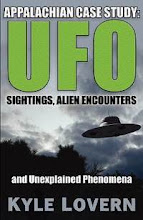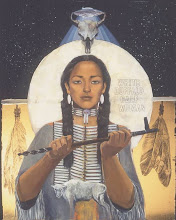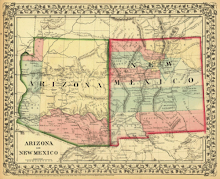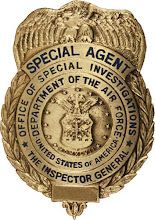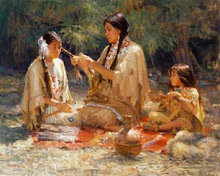Tuesday, April 21, 2009
New book examines West Virginia UFOs, strange encounters
By Steve Hammons
West Virginia journalist Kyle Lovern brings us a straightforward, down-to-earth and amazing picture of UFO encounters and other mysteries from his home state in his new book "Appalachian Case Study: UFO Sightings, Alien Encounters."
An award-winning journalist born and raised in West Virginia, Lovern uses his professional experience from newspaper and radio work in his interviews with other West Virginians about their unusual UFO sightings and other experiences in the Appalachian Mountain region.
He chronicles sixteen separate incidents in which average people came into contact with UFOs, strange creatures and other mysterious situations.
In some cases, Lovern’s interview subjects told him of events long ago – in their childhoods for some of the people. Other accounts reported more recent incidents.
He points out that he used only the most credible cases from highly-reliable witnesses.
At 98 pages in length, the book gets to the point and reports facts and witness accounts in ways that are convincing and very interesting.
SIGHTING AND ENCOUNTER CASES
Most of the book is structured with chapters focusing on each of the 16 cases, although Lovern includes relevant background material at the beginning and end of the book.
In “Sighting One,” 18-year-old Dave, who would later be drafted for the Vietnam War, spots a large somewhat triangular UFO while hunting in the woods. Years later, he has another surprising encounter and may have experienced “missing time.”
“Sighting Two” tells the story of a couple, Bill and Jane, who see a large cigar-shape object. At the same time, their truck engine and electrical system malfunction mysteriously.
In “Sighting Three,” readers learn about the story of a Walt, a man who was 6 years old in 1952 when a bright multi-colored UFO hovered over his rural home. Although his mother witnessed it too, his father seemed in a daze of some kind and did not respond to the extraordinary event.
The sixteen cases are all unique in various ways.
One is a 1966 too-close sighting of the anomalous creature known as the “Mothman” that was seen by many witnesses in West Virginia in the 1960s.
In another incident, a witness named Mary tells of when she was 16 years old in 1955 and saw several cigar-shaped lights flying at tremendous speed over her home in southern West Virginia.
After reading all of Lovern’s 16 cases, readers will get a good picture of the many unusual sightings and fascinating encounters over the decades experienced by West Virginians from all walks of life.
The author notes that West Virginia is not far from Washington, D.C., to the east, or from Wright-Patterson Air Force Base to the west in southwestern Ohio where UFO activities have reportedly taken place over the years.
Lovern wonders if these might be factors related to West Virginia sightings.
In a sense, Lovern’s focus on West Virginia can be seen as a microcosm of other parts of the Appalachian Mountain region as well as other unique areas of the U.S. and the world. Ancient legends of UFOs and visitors from elsewhere are found in many cultures around the globe.
Although we think of modern-day UFO sightings as beginning with the “foo fighters” spotted by U.S. air crews during World War II, other research indicates that UFOs were observed over the U.S. in the 1800s and possibly going back in history for centuries.
MOUNTAIN STATE MYSTERIES
Is there anything else about West Virginia worth looking at when it comes to mysterious phenomena?
The Appalachian Mountain range, sometimes referred to as the Allegheny Mountains, extends approximately 1,500 miles from Alabama north to Newfoundland, Canada.
However, we most often think of the Appalachian region in terms of the southern part of the range, which runs through the states of West Virginia, Virginia, Kentucky, Tennessee, North Carolina, South Carolina and Georgia. Eastern and southeastern Ohio, along with western Pennsylvania, north of the Ohio River, are considered in the central and north-central part of the Appalachian Mountain Range.
Spanish explorers in Florida in 1528 encountered a tribe whose name was interpreted as or referred to as the Appalachee, which evolved into the word Appalachia and identified the mountain range to the north.
Many people today think of Appalachia as an economically stressed region known for coal mining and rural mountain life. However, the region has a very rich and ancient history.
West Virginia and the Appalachian region were the homelands of many Native American Indian tribes. Indians who lived West Virginia and the surrounding region include the Shawnee and Cherokee. Native Americans had lived there for thousands of years.
Europeans who came to the region in the 1700s and included explorers and settlers of English, Welsh, Scottish, Scots-Irish – Celtic backgrounds.
In those days, many marriages between these Europeans and Cherokee Indians occurred. The significant genetic merging of these groups is evident today as many families from the region recall Cherokee ancestry in the family tree.
The Celtic traditions and Native American Indian cultures both have been a focus of interest by some researchers in regard to unique modes of thinking and awareness, and possibly “anomalous cognition,” a term referring to unique kinds of human perception and experiences.
Lovern’s second book on UFOs and unusual phenomena is due out later this summer. If it is anything like "Appalachian Case Study: UFO Sightings, Alien Encounters," it is sure to be a level-headed and factual look at situations that we do not fully understand at this time.
By reading Lovern’s books and getting more information from many sources, we can become more aware of unusual things going on around us, and within us.


















































